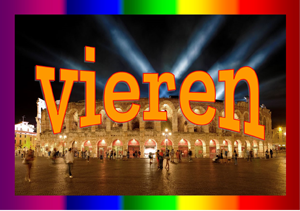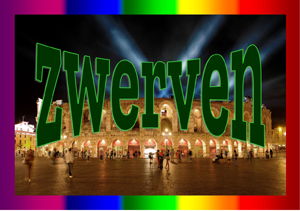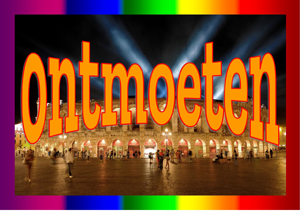By Greg Suffanti
QFWF no. 8, November, 2018
The Stupa is a symbol of the Buddha and his enlightened mind
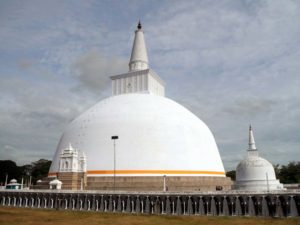
Basically, there are three types of Buddhist structures: monasteries, temples and stupas. Stupas are sepulchral monuments, meaning a place of burial or a receptacle for religious objects.
However, it should be noted that stupas in ancient India were built to honor those venerated and considered holy and pre-date the stupas first built to honor Shakyamuni Buddha, who lived some 2,500 years ago.
The word pagoda is collectively used in Southeast Asia to describe temples and stupas, which can lead people in the West to assume they are the same, when in fact, traditionally, they are quite different from each other in terms of function and use. More on this later.
Historically, a stupa is a mound-like or hemispherical structure containing the cremated remains of a noteworthy being. Buddhist stupas contain mantras, relics (starting with the historical Buddha, Shakyamuni), and other holy artifacts. The Buddhist stupa is the symbol of Shakyamuni and his enlightened mind.
Earlier examples of stupas are those “built by the adherents of Jainism to commemorate their dead”[2].
After the death and cremation of Buddha Shakyamuni, the relics were interred in eight stupas spread throughout India, to represent the eight kingdoms in which he had lived.
In building the stupas, “the relics were placed in the center of the mound and a pole was passed through the middle of the structure linking the relics with the stupa’s top, which created an axis mundi symbolically connecting the mundane and the supra-mundane.
In many stupas, the top of the pillar rises up from the dome and is topped with three circular dishes known as chattra (Sanskrit for ‘umbrella’ or ‘parasol’) representing the Three Jewels: the Buddha, Dharma (the teachings), and sangha (monastic order)”[3].
“Because we can’t see the Buddha, this is something we can see” LZR
In general, there are five kinds of stupas:
- the Relic Stupa, which contains relics of the Buddha and his disciples;
- the Commemorative Stupa, marking various events in the life of the Buddha;
- the Symbolic Stupa, representing aspects of Buddhist teachings;
- the Object stupa, in which he items interred are objects belonging to the Buddha or his disciples; and
- the Votive Stupa, which is constructed in order to collect merit or to make a dedication.[4]
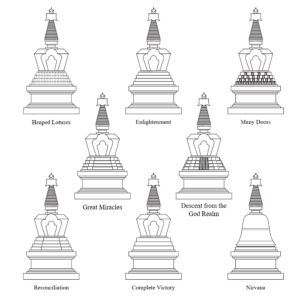
According to the Tibetan Buddhist tradition and Lama Zopa Rinpoche, there
“are eight different types of stupas, each of which commemorate different events in the life of the Buddha:
- Lotus Stupa: the birth of the Buddha;
- Enlightenment Stupa: the Buddha’s attainment of enlightenment;
- Auspicious Stupa with Many Doors: the Buddha’s turning the wheel of Dharma, and commonly referred to as a ‘Wheel Turning Stupa’;
- Miraculous Feats Stupa: when the Buddha performed miracles;
- Descent Stupa: when the Buddha healed the schism of the sangha, also known as the ‘Healing the Community Stupa’;
- Victory Stupa: prolonging the life of the Buddha, more commonly known as a long life or Namgyalma Stupa;
- Reconciliation Supa: when the Buddha healed the schism of the sangha, also known as the ‘Healing the Community Stupa’ and
- the Parinirvana Stupa: the Buddha’s passing into parinirvana”[6].
Whilst all of these technical aspects may sound confusing, as Lama Zopa Rinpoche says, that
“because we can’t see the Buddha now directly, this is something substantial that we can see, a manifestation of Buddha’s holy mind”[7].
“There are 84,000 types of mind” The Buddha
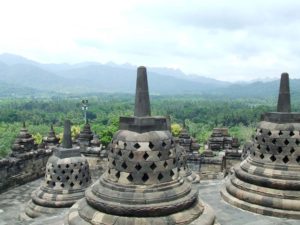
According to Buddhist tradition, Emperor Ashoka, who ruled from 273-232 BCE, took the relics from the eight stupas honoring Shakyamuni Buddha, and erected 84,000 stupas throughout his empire. It is said that the Buddha gave 84,000 teachings to suit the 84,000 different types of mind, and thus the number of 84,000. The Pillars of Ashoka, a series of stone pillars containing various Buddhist principles, and which often accompanied the stupas, are among the earliest sculptural remains in India[9].
The word stupa comes from the Sanskrit word ‘stupa’.
“The Indian concept of the stupa spread throughout the Buddhist world and evolved into such different-looking monuments as the bell-shaped dagaba (‘herat of garbha) of Ceylon (Sri Lanka), the terraced temple of Borobudur in Java, the variations in Tibet, and the multi-storied pagodas of China, Korea and Japan”(2).
The five story pagoda represents the five elements
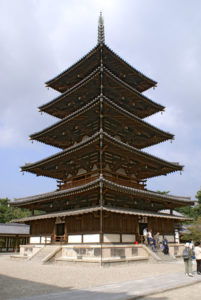
The physical and stylistical evolution of the stupa was greatly influenced by the ancient Indo-Aryan kingdom of Gandara, located along the Kabul and Swat rivers in present day Afghanistan and Pakistan.
It was through Gandara’s significance as a trading route from the 3rd century BCE until the 5th century CE, that the kingdom had an outsize influence on the ever-changing shape and function of the stupa throughout Asia. The ‘Gandara’ stupa evolved from a semi-hemispherical mound to an increasingly elevated shape that eventually became the pagoda tower. It is even thought that structures like the Mahabodhi Temple in Bodh Gaya, which is in the shape of a truncated pyramid with a round, stupa top, was influenced by the stepped stupas of Gandara(9).
There were influences coming from the far East as well, and
“around the middle of the first millennium CE, under the influence of Chinese tower and pavilion architecture, the stupa stretched upward and took the form of a multi-storied tower, the levels (typically 3, 5, or 7) echoing the series of small circular ‘umbrella’ dishes that crown the traditional form”[11] .
In Japan for example, “the five-story pagoda is common, with each story representing one of the five elements: earth, water, fire, wind, and void (sky, heaven)”(12).
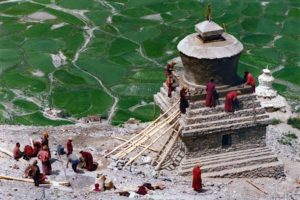
Unlike a stupa, which is typically a solid structure, pagodas are often buildings which can be entered and serve both secular and non-secular purposes.
China, Japan, Korea, and Indonesia make use of pagodas, whereas lands like India, Nepal and Tibet build stupas, however, both are seen as a “a depository of his (Buddha) protective powers and living energy”[12] .
“Just seeing a stupa purifies the mind” LZR
In His “Benefits of Holy Objects”, Lama Zopa Rinpoche (LZR) cites the King of Concentration sutra in which it says
“that even if one sees a drawing of a stupa with an angry mind, it causes one to see 10 million Buddhas in the future”[13] .
LZR continues, saying,
“when the wind blows over and touches a stupa, it becomes blessed and has the power to purify. When the wind then touches sentient beings — whomever it touches, animals or flies or insects or human beings — it purifies their negative karma of having committed the ten non-virtuous actions… they receive a good rebirth in the next life”(13).
There are so many complicated elements that make up the Buddhist canon, however, reverence for the stupa remains a powerful and simple manner to create good karma or energy and purify the mind. LZR stresses this point, saying that he sees
“the creation of stupas as being of incalculable benefit for countless sentient beings, especially their mind streams. If one transforms or develops the mind, then all problems and suffering are transformed or ceased, because the mind is the creator of all one’s happiness and suffering”[14] .
He concludes by saying, “you see, just by seeing the stupa, the minds of sentient beings who come here get purified”[15].
Just as with paying reverence to a statue of the Buddha, respecting Buddhist stupas creates infinite good merit for the future. That’s a very big future result for a very small effort!
So, the next time you see a stupa, don’t forget to circumambulate clockwise around the stupa and known you’ve done a great to help this life and beyond!
Notes
[1] Source: Ruwanwelisaya stupa in Anuradhapura, Sri Lanka
[2] www.britannica.com/topic/stupa
[3] https://www.buddhistdoor.net/features/sacred-stupas-and-precious-pagodas-the-many-roles-of-reliquaries-in-the-buddhist-landscape
[4] what-is-a-stupa
[5] Source: eight types of stupas
[6] holy-objects/stupas-resources
[7] lama-zopa-rinpoche-news/the-benefits-of-stupas
[8] Source: Borobudur, Indonesia
[9] pillars_of_ashoka
[10] Source: pagoda of Hōryū-ji in Japan, 7th century
[11] technology/pagoda
[12] stupa
[13] benefits_blessings_holy_objects_stupa p. 3
[14] benefits_blessings_holy_objects_stupa p. 8
[15] benefits_blessings_holy_objects_stupa p. 9








